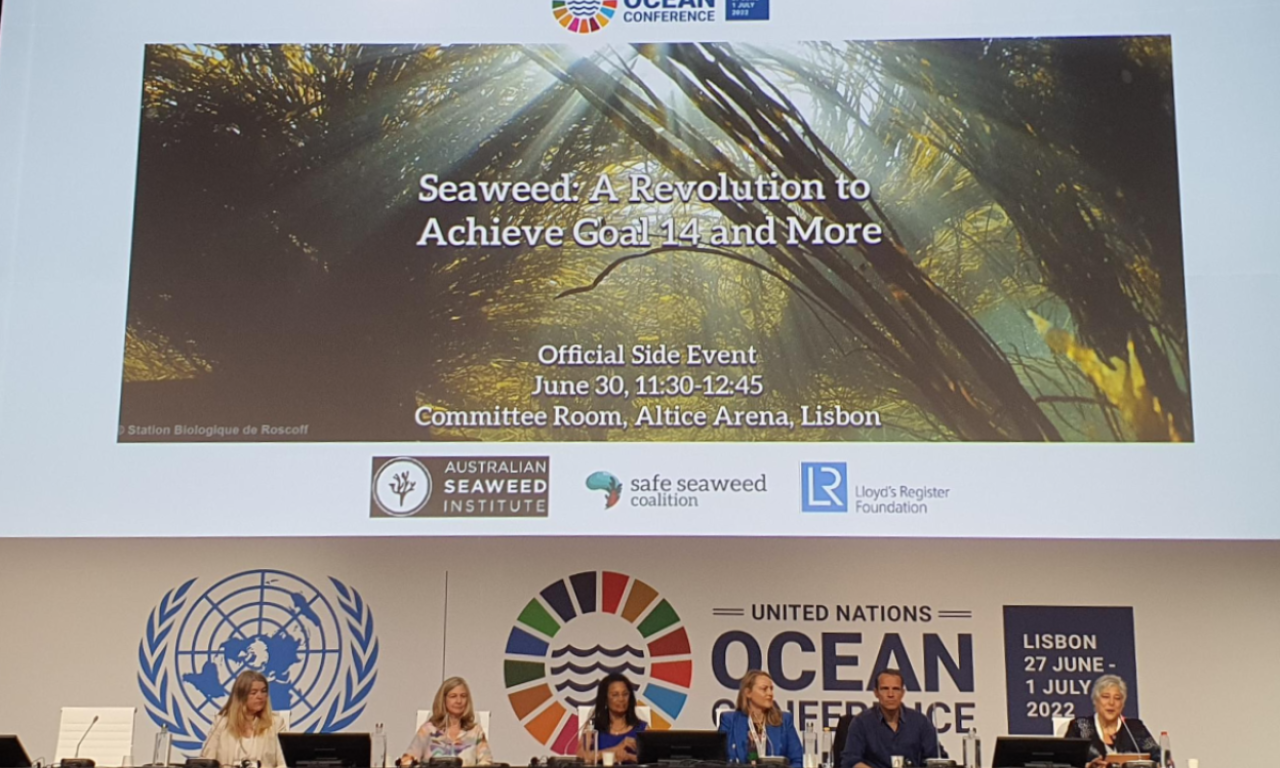
- Vincent Doumeizel identified the potential and opportunities in using seaweed to mobilize a global revolution for sustainable, healthy and climate-equitable diets in his new book ‘La Revolution des Algues’.
- WorldFish’s interest in nutrition-sensitive seaweed production is still in its infancy, with pilot trials happening under the Enhanced Coastal Fisheries in Bangladesh (ECOFISH) Phase II project funded by the United States Agency for International Development (USAID).
- WorldFish’s research direction and innovations would take into consideration the food and nutrition security of producers, consumers and supply chain actors as well as building a seaweed food system that is resilient to disruptive shocks and climate change.
Seaweed left an indelible mark during the 2021 UN Food Systems Summit and the 2021 United Nations Climate Change Conference, more commonly referred to as COP26, as an innovative nature-based solution towards achieving sustainable healthy diets as well as building economic and climate resilience. Hailed as a revolutionary superfood, seaweed is also seen as a means to address social and gender disparity in low- and middle-income stakeholders in the supply chain. We spoke to Vincent Doumeizel, advisor to the UN Global Compact and The Seaweed Manifesto, as well as the author of the new book ‘La Revolution des Algues’, for his insights and opinions on this superfood for the future.
In 2019, the global production of seaweed peaked at over 35.8 million tons, a significant increase as compared to the 2.2 million tons harvested a half-century ago in 1969. Seaweed, or macroalgae, accounted for 5.4 percent of the world’s aquaculture production – the fifth largest aquatic food harvested behind carps, barbels and cyprinids; marine shrimps and prawns; salmons, trout and smelts; and crayfishes.
Seaweed is produced, be it through cultivation or collection from the wild, in 49 countries worldwide – 97 percent of which belongs to the Asian continent. This is reflected in the consumption patterns of seaweed. Seaweed is more commonly consumed in East and Southeast Asia while consumption in other parts of the world is niched, either as a novel or traditional food. This disparity in consumption implies a great potential for the development and cultivation of seaweed for consumption, across many more geographical regions.
In January 2022, Vincent Doumeizel, senior advisor on oceans at United Nations Global Compact launched his book ‘La Revolution des Algues’ identifying the potential and opportunities in using seaweed to mobilize a global revolution for sustainable, healthy and climate-equitable diets. The launch of this book complements his advocacy work for seaweed through The Seaweed Manifesto and his leadership in the first international platform for seaweed stakeholders, the Safe Seaweed Coalition.
“Seaweed holds untapped potential in sustainably feeding our population and animals as well as to support agricultural systems by replacing fertilizers. Seaweed s for new medicines as well as cleaning the ocean and replacing plastic or unsustainable products such as cotton,” elaborates Doumeizel on the opportunities offered by seaweed cultivation.
“Seaweed will not only contribute to decarbonizing the economy but also absorb more greenhouse gases than any tropical forest to mitigate climate change and sequester carbon in the deep sea. Eventually and importantly, it will also provide sources of revenue and jobs to coastal communities where fishing is declining. No one ever really voiced that positive message for a regenerative system both on land and in the ocean. We need to start now and this is the idea behind the genesis of my book,” added Doumeizel.
The book, published in French with translated versions to be available later, received unexpected success in many countries including France, Switzerland, Canada and Belgium. Coupled with the strong media attention given by mainstream media outlets, it has since spurred strong interest to position seaweed as a bold initiative.
“The message has to be heard by investors, food brands, large institutions and the aquaculture world as we need everyone to mobilize and work together to scale up the promising industry safely and sustainably,”ainable manner,” said Doumeizel, who is also vice president of the food, beverage and sustainability for the food program at the Lloyd’s Register Foundation.
“Another message is that we need to protect existing seaweed forests. The ecosystem services provided by these wild forests are second to none on our planet. They absorb and sequester more carbon than any tropical forest on land. However, they also disappear much faster than any land forest. Although seaweed has been resilient so far, the rapid anthropogenic changes in our environment put them at high risk,” cautioned Doumeizel.
Seaweed as a new frontier

The potential and opportunities mentioned by Doumeizel are not in isolation, as they are also echoed by Shakuntala Haraksingh Thilsted, WorldFish’s global lead for nutrition and public health. In her engagements as vice chair for Action Track 4 of the 2021 UN Food Systems Summit, conversations on seaweed stirred her interest and she soon saw the potential of optimizing this low-trophic food for its nutritional and livelihood benefits for low- and middle-income communities, very much like her award-winning nutrition-sensitive approaches with small fish.
“Seaweed holds great potential to nourish people and our planet. It is an aquatic superfood, providing multiple, highly bioavailable micronutrients and essential fatty acids that are crucial for optimal growth and well-being. In addition, seaweed also creates new possibilities for income and livelihoods, especially for women in low- and middle-income countries,” said Thilsted, who is also the 2021 World Food Prize Laureate.
WorldFish’s interest in nutrition-sensitive seaweed production is still in its infancy, with pilot trials happening under the Enhanced Coastal Fisheries in Bangladesh (ECOFISH) Phase II project funded by the United States Agency for International Development (USAID). Through these trials, 200 women farmers were trained to cultivate seaweed off the coast of Cox’s Bazar resulting in them being the largest contributor to the nation’s seaweed production. These farmers harvested up to 20 metric tons of seaweed within a short cultivation window from October to March.
However, seaweed consumption in Bangladesh is still poor, with seaweed mostly consumed by tribal people of the hilly areas around Cox’s Bazar, whereas, most of the harvest is exported to South Korea for processing and distribution to other markets. This partnership effectively improved the livelihoods of women with each household obtaining additional income that is spent on nutritious foods for consumption.
“By adopting nutrition-sensitive approaches to seaweed production, we can increase production and productivity of seaweed in more countries and at the same time, build awareness and demand for consumption of this nutritious superfood, especially among those who are nutritionally vulnerable such as women and children in the first 1,000 days of life,” added Thilsted.
Seaweed in the WorldFish research agenda

At present, there is strong competition for the use of seaweed and its products in many diverse sectors, including the production of animal feed, food stabilizers, cosmetics, pharmaceutical products and biofuel. This high and diverse demand, complemented by low inputs for production, has driven many to spur the development of seaweed cultivation, including stakeholders in Malaysia.
In 2019, Malaysia ranked eighth in the world’s seaweed production value with a 0.53 percent share. The Department of Fisheries has identified seaweed as a priority sector for growth and is looking for innovations and collaboration to increase production value and global share. Research institutes such as Universiti Malaya, Universiti Sains Malaysia and Universiti Malaysia Sabah are among the public institutions earmarked as contributors toward this desired growth.
Similarly, WorldFish is keen to build on this growth momentum but would have to take a different approach as compared to the other institutes. WorldFish, building on the 2030 CGIAR Research and Innovation Strategy, will position the innovative use of seaweed for food, land and water systems transformation, leaving no one behind. WorldFish’s research direction and innovations would take into consideration the food and nutrition security of producers, consumers and supply chain actors as well as building a seaweed food system that is resilient to disruptive shocks and climate change.
‘La Revolution des Algues’ is a good start to identify ways that global citizens can use seaweed to effectively transform the way food is produced, supplied and consumed within the framework of sustainable and climate-equitable diets. As each community, country and geographic region have its respective opportunities and limitations to using seaweed, the onus lies on strong partnerships such as that with CGIAR and WorldFish to effectively introduce approaches and solutions that can maximize the potential of this superfood from the sea.
“We need to work collectively with other food systems because there cannot be regenerative farming without the ocean. In the end, we need to make everyone aware that seaweed may well be the greatest untapped resource on the planet. It has the potential to play a globally significant role in addressing food and nutrition security, climate change mitigation and marine biodiversity loss, as well as contributing to several Sustainable Development Goals, including sustainable job creation, economic growth and gender equality. We must strive to be the first generation on this planet who managed to nourish the entire population with safe and sustainable food by reconnecting land and ocean,” concluded Doumeizel.
